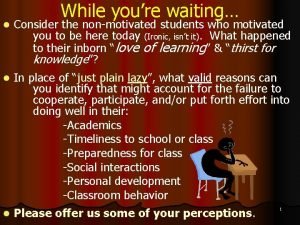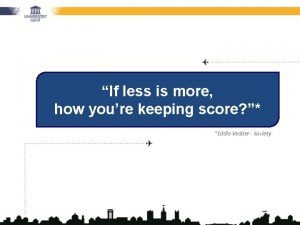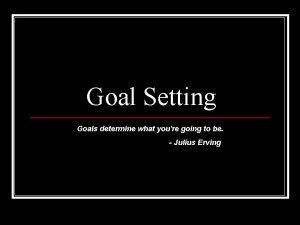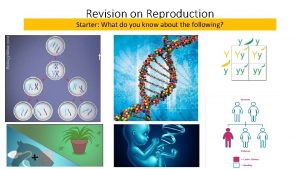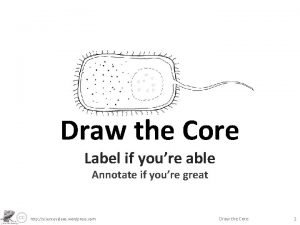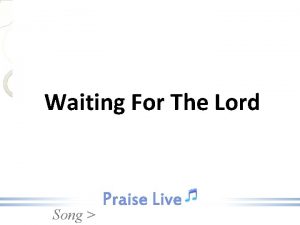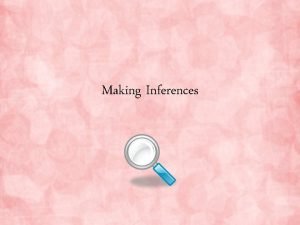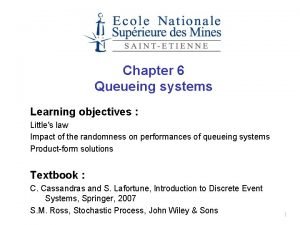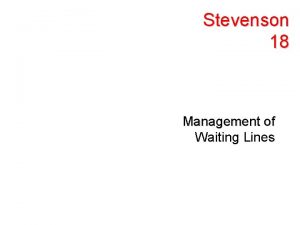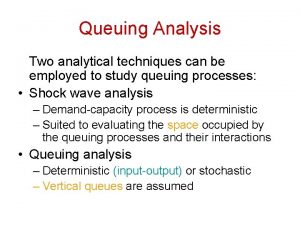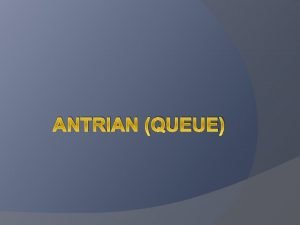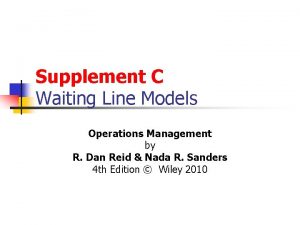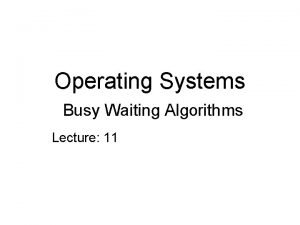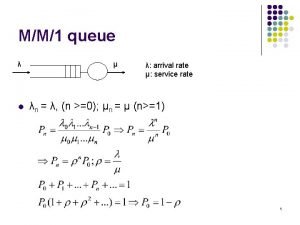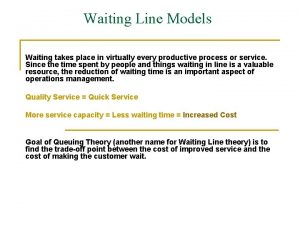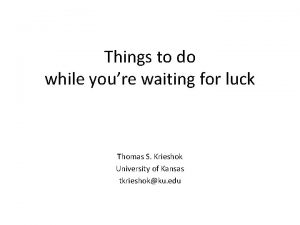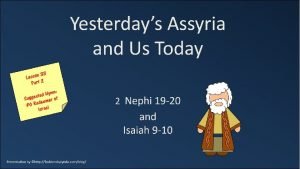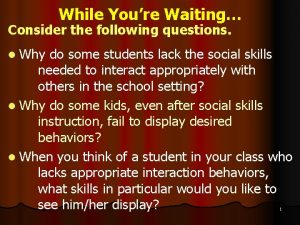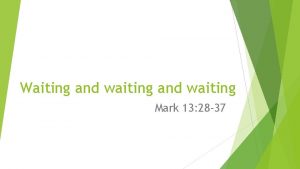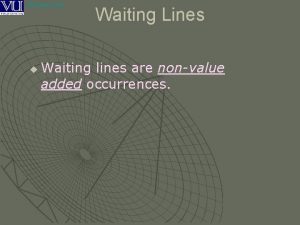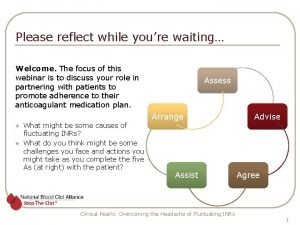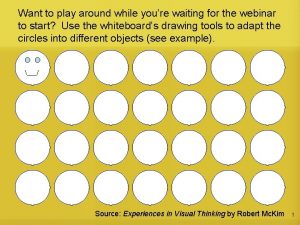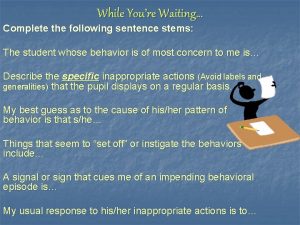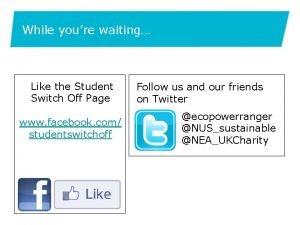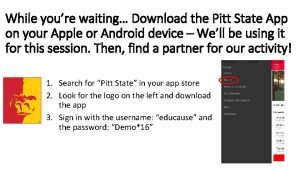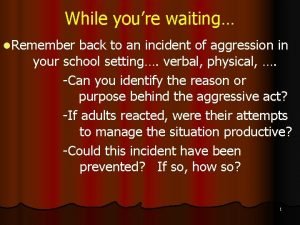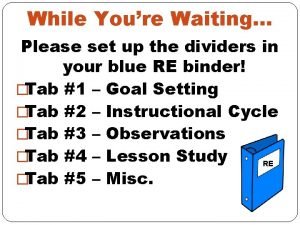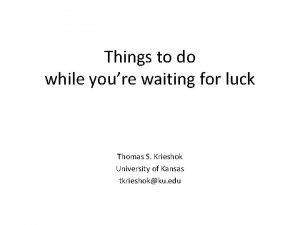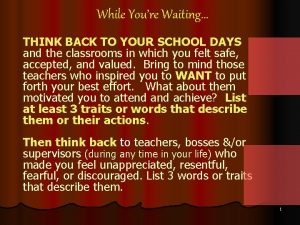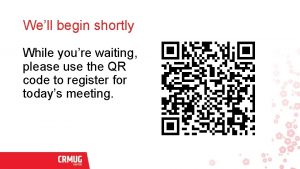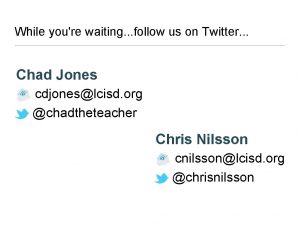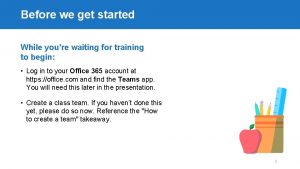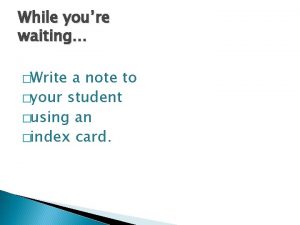While youre waiting l Consider the nonmotivated students


























































































- Slides: 90

While you’re waiting… l Consider the non-motivated students who motivated you to be here today (Ironic, isn’t it). What happened to their inborn “love of learning” & “thirst for knowledge”? l In place of “just plain lazy”, what valid reasons can you identify that might account for the failure to cooperate, participate, and/or put forth effort into doing well in their: -Academics -Timeliness to school or class -Preparedness for class -Social interactions -Personal development -Classroom behavior l Please offer us some of your perceptions. 1

What are some common reasons why youngsters fail to engage in a task, activity, or endeavor? Lack of skill or knowledge base to handle the task. Different learning style or need for supports/SPED. Doesn’t see importance/connection to his/her life. Fear of losing in competition. (Research: Kids motivated more by collaboration than competition…group competition OK) Rewards for success are meaningless, trivial, and/or fail to build inner motivation to achieve (i. e. , candy, points, contraindicated praise or criticism). Lack of belief in ability due to past failure & negative comments of significant others (parents, peers, teachers) Fear of looking “dumb” if fail (Forced choice: Bad vs dumb) Mistakes perceived as failure rather than opportunity to learn (ala Bernard Baruch & Mrs. Frizzle) Others? (“Drill & kill” or boring instruction) 2

Interventions for: “Lack of skill or knowledge base to handle the task”? ^ I. D. gaps in the learning/skill sequence with criterionreferenced testing. Teach the skills, procedures, or information they don’t yet know. 3

Interventions for: “Different learning style” or “Need for supports/SPED” ? ^ – “Differentiated instruction”: Modify the presentation/instruction materials procedures expectations – Ensure understanding by having the student repeat the directions in his/her own words. – Ensure initial engagement into the assignment. – Check in early & often with the student to assure understanding & task engagement. – Simplify a complex behavior by utilizing “shaping” or “task analysis”. (Both found on Behavior. Advisor. com) 4

At Home (& packed into my suitcase when I travel). 5

Interventions for: “Doesn’t see importance or connection to his/her life”? ^ Relate the content & assignments to their lives. Query them about their future aspirations. Tie material into that future. Locate admired/admirable people who use the content in their daily lives & jobs. For more info, go to http: //www. behavioradvisor. com/Motivation. html 6

Interventions for “Fear of Failure”? ^ “Clickers” (Make mistakes anonymously) Assign peer helpers/cross age tutors. Develop activities & assignments that: – Reduce individual competition – Involve team competition (rather than individual). Focus on improvement versus precision. Focus on the putting forth of effort, not accuracy. Reminisce previous successes resulting from persistence. Avoid reassurances such as: – – – “C’mon, it’s EZ. ” (from teacher or peers) “You know how to do it. You did it yesterday. ” “Maybe if you pay really close attention this summer, you be able to pass the exam. ” BUT WHY? ? ? might Go to: http: //www. behavioradvisor. com/Motivation. html The Secret Curse of Expert Archers, s The Secret Curse of Expert Archers, KATIE THOMAS, August 1, 2008, NY Times 7

-Would you want to be doing what you’re asking your students to do? -Two kids nod in agreement with the teacher. One is thinking about a video game. Interventions for “Inattentive Due to Lack of Captivating Instruction” ^ http: //www. jimwrightonline. com/php/interventionista/intervention ista_intv_list. php? prob_type=off_task__inattention http: //interventioncentral. com/htmdocs/interventions/motivation/ motivation. php http: //interventioncentral. com/htmdocs/interventions/gen. Acade mic/spark. php http: //www. behavioradvisor. com/Teaching. Tips. html 8

We I. D. the reason via an FBA, which is a set of precise & complex procedures for… …helping the Committee on Special Education arrive at the wrong conclusion with great certainty. …determining the motivation for, or function of an aberrant behavior pattern. Question: Does it make sense to seek the motivation for nonmotivation or the function of lack of functioning? Unless the absent enthusiasm for learning is due to special needs (SPED, language, learning style), the usual procedures: Medical check Achievement testing I. Q testing A-B-C analysis & “anecdotal notes” are pretty much useless in identifying the purpose. 9

Dreikurs’ Mistaken Goals. ^ When struggling or insecure, will seek support & guidance. If not feeling accepted & supported… Attention. Power Seeking. Revenge. Inadequacy/withdrawal. 10

Another Way to Determine The Reason ^ If the youngster doesn’t respond to your assessment question (“When you pretend that you’re not capable of doing the work, are you trying to make me go away? ”), you can still identify the “Mistaken Goal" via these guidelines: If you feel: The student is probably seeking: Annoyed ? Threatened ? Hurt ? Disheartened (at inability to reach this student) ? If a student: Then the probable goal is: Stops a behavior, but then repeats it ? Refuses to stop and increases the misbehavior ? Becomes violent or hostile ? Refuses to cooperate, participate, put forth effort, or interact ? 11

Interventions for Inadequacy? ^ NEVER show frustration. This reaction may reinforce a sense of worthlessness. Offer encouragement & support. Do not criticize unless using a “criticism sandwich”. (later) Blame lack of success on the curriculum, materials, or the way you taught the lesson. Do not blame the student. Set up kids for success. Focus on recognizing effort, not accuracy or grades. (later) Use praise in an informed & skilled manner. (later) If slight effort was exerted, positively acknowledge it via “partial praise” (later) & focus on ways to improve in that area. Have the student self-evaluate, identifying what parts of the task were done correctly & incorrectly. Then have him/her develop a plan for improvement (or have him/her redo the task well). Assist & support as needed. For more information on Dreikurs’ model & interventions, go to www. Behavior. Advisor. com/Why. Kids. Misbehave. html. 12

Today’s Focus Strategies that accomplish the following (simultaneously): – Enhance chances of task engagement (especially with “defensive” & “passive” pupils) – Develop a “can do” (or “will try”) attitude in kids – Strengthen student-teacher relationships (“Belonging”) This Session’s Agenda: 1. Avoiding verbal blunders that undermine our efforts to motivate students. 2. Offering criticism that’s constructive (not destructive) & promotes motivation to achieve. 3. Giving praise & positive recognition that builds (& maintains) an internal drive to achieve 13.

Don’t say “DON’T”, Stop using “STOP”, & No using “NO”. NO cheating!! Quit bellyaching! Stop stopping! Don’t be talking to your neighbor. Speed Round! Rephrase the following. Identifying the desired actions. Do so quickly to simulate rapid rephrasing after having uttered such comments. Quit talking. Don’t be rude. No insults, knuckle head. 14 NO BOOGER PICKING!

A student reluctantly walks to the front of the room to read his/her composition. The class becomes noisy & inattentive during the reading. “I’m really disappointed in what I’m seeing and hearing right now. From experience, I know that I can expect better (Adolescents: “more mature”) behavior from our class. Right now, I need for everyone to be looking up here with mouths closed and ears open. (Direction stating what they OUGHT to be doing) Thank you (a positive “you” ). I know that we’ll listen closely now, giving our classmate the same respect we would want in this situation. ” (Belief Statement). 15

Defusing “The Conflict Cycle” Situation: A teacher uses respectful voice and wording to de-escalate an emerging bad situation. She also discovers the reason for the “defensive behavior”, & works WITH the student to solve the problem. Jim Wright’s video from Intervention. Central. com 16

Lots of Eye Messages Lots of “I messages” I need for all…. In 30 seconds, my eyes should be seeing… All the noise is making me… Success in this endeavor requires that all of us… Right now, we should all be… Our mission at this moment is to… Be sure that any “You’s” are positive or neutral. Avoid any accusatory or negative “You’s”. 17

Select the properly phrased “I message(s)”. Before each class, eye brows through my lesson plan. 1. “I get perturbed when you become an academic couch potato. Get in the game. ” 2. “I need for all of my students to be moving their pencils on their worksheets. ” 3. “I’m unable to teach when you’re so noisy. ” 4. “I see that you’re out of your seat again. ” 5. All of the above (numbered) statements are properly phrased “I messages”. 18

“Use your garbage mouth again & you’re headed to the office. ” Select a negative “YOU Statement”. Imagine the “With your attitude, you’re gonna end up dead or on welfare. ” situation in which it was said. Rephrase it. (Self or partners) “You’ve got more excuses than any 12 people I know. You know, it’s not that you’re stupid. You’re just lazy. ” “I give up. You’re more trouble than you’re worth. ” “Why do you just give up? You never raise your hand for help. ” “Why are you out of your seat again? Are you hyperactive or rude? ” “If you’re not writing, you’re not earning points and you can’t go. ” “You’re gonna fail this course cause you don’t do the homework. ” “You’re too noisy. Why do you always have to be so loud? ” BETTER YET: Recollect a “negative you message” heard recently. Rephrase it. * * Feel free to disapprove of the BEHAVIOR, but NOT the student’s CHARACTER or SENSE OF SELF. (“Symptom Estrangement” or “Descriptive Criticism”). 19

20

Application. . . A frequently off-task youngster is again drawing others’ attention from their assignments with his clownish behavior. Right now, he is using pencils to roll back his eye lids. He then bulges his eyes and sticks out his tongue. How would you replace the following contra-indicated response? “Are you crazy or somethin’? What’re you doing that for? Keep showing that numbskull behavior and you’re losing points. Don’t be pushing me, knuckle-head. ” 21

Critical of Criticism Why not: – Tell it like it is / Tell it to ‘em straight / Draw the line – Set limits / Pull in the reins / Put on a leash – Let ‘em know it’s not OK to do in my class – Let ‘em know who’s boss here – Put ‘em in their place – Point out where they need to improve ? – For example… (Psycho-T on CD) 22

Research on Criticism Older adolescents after public criticism: – 1 in 10 performed same or better on the task – 9 in 10 performed worse – Nearly every one of over 80 students reported one or more of the following: Feeling bad about oneself. (“I can’t do anything right. ” “I’m stupid. ”) Resentment toward the treatment. 23 Dislike for the person who criticized.

More Criticism of Criticism A teacher in a “good classroom” no longer praised students for being “on task” or “working”. She chastised students for being “off task”. The result? The off task behavior of observed students increased from 8. 7% to 25. 5% of the time. 2 nd phase: Teacher increased criticism from average of 5 times per minute to 16. Off task behavior of observed students increased from 31% (pre-test) to over 50% of the time (post-test). Why did these results occur? FMToon Marshall Memo review Summer 2007 24

Partial Praise. Research with adolescents: Math & Littering Grp 1: Recognized for tidy actions & math procedures (even though not yet proficient) Grp 2: Criticized & directed to engage in actions Grp 3: No feedback. Results: 1 st made gains on both. 2 nd & 3 rd, no change. 25 T. Thorkildsen (2007). Adolescents’ moral engagement in urban settings. Theory into Practice, 46 (2), 113 -

Partial Praise Practice As your assistant teacher continues with the recitation of the spelling words for this week’s test, what would you say to Gayle after comforting her and convincing her to join you in the back of the room? What would you positively recognize? What alternative response might be identified as the two of you “problem solve”? (click 4 steps) Gayle Video Tape . 26

So then, what do we utter in place of criticism? …besides “I messages” & “Partial Praise” (with encouragement)? “Proximity Praise”? “Sandwich”. Eg 27

C - Sandwiches: Emotional Health Food ^ Kneeling down & facing the student, the teacher quietly says: “Fran, during the last 10 minutes, you were really focused. It shows in the quality of your work. We all take short brain breaks, but we need to draw those eyes back to your paper. I looking forward to reviewing your work with you later. ” Luis, I appreciate your help in keeping Rodney on task. However, prodding someone to finish so that you can copy his answers deprives you of true learning. From now on, I look forward to seeing you working hard on your own assignment inbetween the reminders to Rod. Pon 28

Which one is the properly phrased “Criticism Sandwich”? 1. “You can be proud of remembering to capitalize the first word of each sentence, even if you forgot to use any punctuation. So what do we need to remember? Right. Don’t leave out those commas, periods, and question marks in the next draft. ” 2. “You’ve added many more adjectives, creating a more interesting piece. Now let’s focus on adding more adverbs in the last rewrite. You’re getting the hang of adding details, and I’m anxious to read a final draft with even more detail. ” 3. Both of the above items are examples of wellworded “criticism sandwiches”. Activ 29

Criticism: Better digested when placed between two compliments. Think of a recent event when you gave (or avoided giving) criticism. If you could go back to that time, how would you have phrased the “sandwich”? OR… M. J. usually arrives about 10 minutes late (if at all) to your class. Today, s/he passes through your classroom door about 20 seconds after the bell. (Progress!) Your other students are still working on the “Do Now” activity. Ans 30

Better late than never. “Hi MJ. Good to see you. Thanks for making the effort to get here in a more timely manner. It’s appreciated. 1. C’mon in and get yourself settled while I tell you about the “Do now”. (Teacher walks with student to his/her desk, explains the task, and as leaving and removing a hand from the student’s shoulder, says…) I’m getting a ‘high 5’ ready for tomorrow when you beat the bell. ” 2. OR… Please understand though, that I’m still under the same constrictions as before: I’ve got to ask you to stroll down to the office for a late pass. But like I said, I really appreciate your effort to get here on time. I’ll be sure to get my fingers warmed up to give you a ‘high 5’ when you beat the bell tomorrow. 31

RESEARCH: The most effective strategy for promoting motivation, cooperation & on-task behavior is… Recognition for appropriate behavior Non-verbal approval – Smiles – “Thumbs up” Written commentary – Notes – Comments on papers Verbal approval – Acknowledgement (“Tammy has her materials ready. ”) – Praise P’em? ! TNot. Par 32

When Praise Doesn’t Perform Many self-proclaimed ‘no-nonsense’ teachers insist that “It doesn’t work” … And for them, it didn’t. (But why? ) Meanwhile, a large percentage of praise given profusely by well-meaning teachers is ineffective or counterproductive. (But why? ) Has it happened to you? You praise a student who, upon hearing the compliment, acts up. What might be some reasons for why praise sometimes fails? 33 Usual susp

The Usual Suspects. ^ Teacher’s fails to be consistent and persistent. Student perceives that s/he has completed enough of the task adequately, & can take a break / quit. A well-behaved, motivated student is fearful of being victimized in a classroom staffed by a “weak” teacher. Teacher is viewed as being judge & jury, not unswervingly supportive. Student does not like or respect the teacher. Student is from a culture or household that doesn’t use much praise. Student is member of a minority group historically not given respect & esteem. Their “folklore” differs from that 34 of “voluntary minorities”.

Praising “praise resistant” kids (suspicious of authority, your culture, bad history with teachers & learning) before interpersonal bonds develop^ Personalized public praise can provoke misbehavior designed to avoid the appearance of subservience to authority. Give private praise or send notes privately ~ Replace specific public praise with general praise to unspecified pupils: “I love the way that Casper is copying down today’s learning goal. ” becomes? “Students who are copying down the learning goal are showing me that they are leaders. They’ve got my respect. ” 35

NEXT: A closer look at the practice of positivity & some tips for effective praising that will ensure that kids respond to it well & feel like they’re . 36

Praiseworthy Praise? Watch our colleague in this next video clip. Observe her style of praise. – Your thoughts? – Compliments or suggestions for her? – Do you have a similar style of responding when a student’s product shows improvement? Teacher praises student product (in computer) or http: //www. usu. edu/teachall/video. htm (slow load from internet) & select Group Contingency: 2: 30 into clip 37

“Thanks for submitting the assignment, Lee. I’m pleased to see it. ” “Wow. Stupendous job, Lee! This is an especially fine piece of work. Intelligence, effort, and precision fine. PRAISE: Always Praiseworthy? motor coordination beautifully combined in one exceptional A student, easily capable of submitting paper. You’ve got more grey matter inside Situation: that skull of yours than any 12 people I know. ” high-quality homework assignments, does so for Super! You know, I’ve been waiting a looonnnngggg the first time in a month. It’s inferior work (for this for you to submit this paper. What’s it been, student), but at least something has been Lee…four weeks since I’ve seen anything from you? produced. Hey, keep it up, and don’t make me wait so long for the next one, OK? Of the 4 praise options you’ll see, which one is Alright Lee! Let’s give you credit in effective” the grade book proven in research studies to be “ ? away. Turn in one every day now, huh? right(Results in improved behavior or achievement) 38

Analysis? “Thanks for submitting the assignment, Lee. I’m pleased to see it. ” “Wow. Stupendous job, Lee! This is an especially fine piece of work. Intelligence, effort, and precision finemotor coordination beautifully combined in one exceptional paper. You’ve got more grey matter inside that skull of yours than any 12 people I know. ” Super! You know, I’ve been waiting a looonnnngggg for you to submit this paper. What’s it been, Lee…four weeks since I’ve seen anything from you? Hey, keep it up, and don’t make me wait so long for the next one, OK? Alright Lee! Let’s give you credit in the grade book right away. Turn in one every day now, huh? 39

Contra-indicated Types of Praise ^ Unearned Praise Praising substandard (for that child) academic or behavioral performance conveys the message that “The work is fine… for a person of your low ability. ” INSTEAD? What do you say when a student’s performance isn’t up to expectations, but at least the pupil gave you something (for a change)? “Caring Criticism” in a “Sandwich” eff 40

Effuse Praise Lavish praise for a non-demanding accomplishment – “Holy moly! Fantastic job of passing out papers! – “Great Googily Moogily! That’s a spectacular job of hamster cage cleaning. You’re a super-duper pooper scooper!” – Gives students incorrect perceptions of their performance (After age 7 or 8 they simply dismiss it as being insincere). When youngsters accomplish a nonchallenging non-academic task/duty of which they are quite capable, it is best recognized with? Fain “Thank you. ” (…if contextual cues make the reason clear. ) Or Description of outcome: “Your paper has the proper heading. 41”

It wasn’t “effuse”. Those kids deserved the praise that I gave to them! So what went wrong in this situation? Tony video (in computer). And on the other end of the spectrum… 42

Faint (“Back-handed”) Praise Avoid praise that hints at past problems – “Monique! Good to see you arrive on time for once. ” – “Jonaya: I’m elated to see a completed journal reflection today. It’s the first one you’ve done all week. ” – “Wow. I’m shocked…Flabbergasted! I never thought you’d pass that exam!” – “Welp, it took forever; but you finally got the steps in the right order. ” – “Wonderful. This is the first time you’ve ever earned all your points for the morning session. ” – “You were paying attention today, Jazz. I just might have to change my opinion of you. ” – Your challenge: Rewrite one of the above statements to offer praise for an accomplishment… without degrading the act by bringing up a history of failure. Reminisce only about positive actions. 43 Con

Controlling Praise (Ulterior motives) Directs (rather than encourages) future performance. “Dajour, you’ve used excellent indentation and punctuation up to this point. Be sure to keep it correct until the end of your composition. ” Research (Kast & Connor, 1988 - 3 , 5 & 8 graders): “Keep it up. ” praise destroyed student motivation to continue with the desired behavior. “Nice penmanship in your journal entry today. You should write that legibly every day. ” (Instead? ) “Nice penmanship in your journal entry. With those well-formed letters, the reader can give full attention to the content. ” 44 rd th th Perf

Praising High Scores or “Perfect” Behavior ^ Why not recognize exceptional performance? “You got all check pluses on your homework this week. ” “James: 100%. . . The only one in the class. Well done. ” “Good boy, Calvin. You worked in your group without once causing a problem. ” Focusing on “nearness to perfection” promotes the view that: – Scores & grades matter more than learning. – Perfection must be attained & maintained at all costs. In pursuit of that praise, kids often? – Cheat & use deceit (due to failure anxiety). – Avoid engaging in academic or behavioral challenges in which they might fall short of “perfection”. Labl 45

Labeling Praise What could be wrong with saying things like: – “Good boy. ” – “See? You’re a smart kid. ”? Few kids (& adults) are fully “Good” & “Smart”. We look bad if the student is thinking: “You’re not very with-it. I got all these answers by text messaging my sister while you were helping others. ” The positive label may be at odds with what has been persistently heard by the youngster. – “Boy, have you got it wrong! That label doesn’t fit comfortably at all. Here’s who I really am. ” – The student then displays behavior that is consistent with his/her present identity (e. g. , head down, destroying 46 paper, talking with others, playing with items). Harv. Me: Supre complim Harv. Me: Supre

Devoid of supporting specifics, positive labels result in Labels are for jelly jars, not kids a psychological “house built on sand”, one easily destroyed by comments / actions contrary to the label. This contrast causes great emotional distress as one’s self image is threatened. Any failure indicates that they might not really have “the gift” or be “a good kid”. This failure doesn’t promote persistence in overcoming obstacles… In their minds, success comes “naturally” to those who are “smart” or “good”. Having to try hard proves they’re not smart or good. They seize opportunities to show their strengths (even when it is not appropriate), and seek constant approval (“Was I a good girl? ” “Am I smart? ”) because they don’t know what constitutes “being good” or being “smart”. Dwek 47

th grade Carol Dweck’s Research Three groups of students in 5 (S=400) Phase 1: Members of each group work one at a time on a challenging puzzle task (non-verbal IQ test) that all can complete successfully. The groups received different praise when done. – For effort: “You got a score of ‘x’. You must have worked really hard. ” – For grade received: “Wow. You got a score of ‘x’. – For being ‘smart’: “Wow. You got a score of “x”. That’s a very good score. You must be really smart. ” – Results: The groups were equally excited about taking similar tasks home to practice. They were equally confident about future performance on this sort of task. 48

Phase 2 of One Study: So what’ll it be? Hard or easy? The groups were given a choice of “…a challenging task from which they could learn a lot, but might not succeed” (Non-verbal puzzle task designed for 7 th graders) OR “an easier task on which they were sure to do well”. Were there differences between the groups? 90% of “effort” group chose the challenging task. Most of the “smart” group selected the easier one Why the difference? They seek out non-challenging tasks in order to maintain the unsupported image of “smart”. 49

Groups were given a more difficult set of Phase 2 of another study: Difficult task. problems on which they wouldn’t do well. The effort group persisted longest on the task. The ‘smart’ kids gave up sooner because…? So…is false hope better than no hope at all? Students were asked: “Did you enjoy the task? ” ? Was there a difference in responses? Those praised for effort enjoyed the difficult task at least as well as the first one. They didn’t view their performance as reflecting upon their intelligence. ‘Smart’ kids started to question their intelligence. Dweck: “They were dependent on continuing praise in order to maintain their confidence. ” So what do we do when kids seek our continual positive input? (“Was I good? ” “I’m smart, right? ”) To next slide… 50

If Time: Responding to Attempts to Secure Praise^ In your groups: How would you respond to each? “I put the paper scraps in the trash can. ” “Yep, that’s where it goes. Thanks for the help. ” “Tyrice can’t do it, but I can. ” OR “They can’t do it and it’s so easy. ” “How were you able to do it? ” (Have him/her task analyze/delineate the steps/strategies …unless N. A. ) (Then) “Would you help Jimmy do it by telling him the steps and showing it to him? ” (after winning a group “Family Feud”) “We’re the best! We’re #1!” “What are some of the things you did so well that made your team so dog-gone good at that game? ” “Did I get them all right? ” (Use descriptive praise to identify the appropriate behaviors and/or use a “Sandwich”. ) 51

All 3 groups were called back to engage in a task Continuing on (another study). with a level of difficulty similar to the tasks of Phase 1 in which all groups were successful. Were all groups again equal in their performance? The “smart” kids’ performance was the worst of the 3 groups. The “smart” kids performed worse than on the original “easy” tasks! (phase 1 of the experiment) The kids praised for their effort did the best & improved their performance over the initial task. 52

Outcomes Those praised for intelligence developed a “fixed view” of it. “You’ve either got it or you don’t. ” Those praised for effort developed a “flexible view” of intelligence. “It’s like a muscle. Exercise it and it will get stronger. ” T Similar results were obtained in her research with kindergarten students praised for being “smart” or “good” (Behavior). 53

Research in highly selective colleges revealed the same Flexible versus Fixed Views of Intelligence. results as in the public schools. AND… with regard to African American students in particular… (Blackwell) Life Sciences Magnet School (East Harlem). 2 groups: – Group 1: 8 session workshop teaching study skills – Group 2: Same as above & module on how the brain grows neurons when challenged. – Teachers were able to identify students from each group – Grades & motivation improved in latter group. (Aronson & Fried, 1998) One’s view of intelligence can be changed! “Minority students” were shown a movie of changes that take place in the brain every time one exerts effort. Then they were told about the relationship between effort and intelligence. This group went on to earn significantly higher grades than the control group. 1 Drawbck 54

There’s one drawback to focusing solely on the putting forth of effort. What might it be? Effort won’t improve performance if students don’t have the necessary prerequisites & supports. We must teach the skills, information, & knowledge that bring benefits from effort. But promoting effort helps them learn the prereqs! Each part supports the other. 55

Teaching Kids to be value challenge, exert (In your groups) What are some skills and talents that effort, and become “Smart” & “Good” we can teach, and then prompt/praise, in order to promote a flexible view of who they are and can be? (academically and behaviorally speaking) (3 min) – Study strategies, Organizational skills – Concentration – Steps followed, Approach, “Plan of attack” – Being creative (Brainstorming: 100 uses for brick) – Use of role-played social skills, anger management skills, tolerant (re)actions, etc. – Persistence & “flexible persistence” (going to “Plan B” when first attempts don’t work) – Facts, rules, mneumonic devices – Use of assistive technology . 56

Withhold the Verbal Rubber Stamp ^ Avoid assigning labels, even positive ones: – “Great actor” – “Nice girl” and other ones you’ve heard like? – “Phenomenal speller” – “Talented artist” – “Super athlete” – “Wonderful reader” – “Great helper” Instead, describe the ACTIONS that deserve positive recognition. [Let kids (re)label themselves if they wish to do so] 57

Examples “Excellent prediction, Farrah. You had to be listening closely to be so detailed in describing what you thought might happen next. ” “Lamont, I’m impressed with how you went to the glossary to find definitions. ” “Hey. Jackson. C’mere. I gotta tell ya… I’m really impressed with your decision to return to class after the fire drill when others took off for the hills. It takes a lot of self-control and maturity to make these types of responsible choices. Give yourself a pat on the back after you get one from me. ” 58

Self Recognition (& self-praise) Place the onus on the youngster… Have the student identify the appropriate actions that should be or were displayed. “When the time comes to present your powerpoint session to the class, what things are you going to remember to do? ” (Prepping the student for success) “I’m a happy teacher when I look at this project. Why? ” I just saw you do something that made you look very mature and responsible. Did you notice it too? “You can be very proud of yourself right now. Why do you think I say that? ” Have them further delineate statements such as “I gave the right answer. ” or “I did what I was supposed to do. ”, etc. 59

^ DESCRIBES the – actions that were demonstrated – thought processes used – approach taken to address the issue. Focuses on EFFORT & PROGRESS. Better behavior & grades follow. However, we’ll still focus on what got them to that point: persistence & hard work. toon 60

Avoid saying “Good” or its vague & nebulous variations (“Nice job. ” “Great. ”) in isolation. Be specific. Give details. Elaborate on what you mean by “Good”. Adele Faber & Elaine Mazlich (1995, Summer). Praise that doesn’t demean, criticism that doesn’t wound. American Educator, 19(2), 33 -38 Toon 61

Avoid labels and generalities that offer little, if any, helpful feedback on one’s performance. How would you improve on the statement in the final frame? Adele Faber & Elaine Mazlich (1995, Summer). Praise that doesn’t demean, criticism that doesn’t wound. American Educator, 19(2), 33 -38 62

Say What You See “I like the way that you…” “Ooh. The … (noun) is very… (adjective). ” “You’re a wonderful writer. ” becomes… “This piece is so colorful and captivating. The passages bring vivid images to mind. That’s because now you’re adding a wide variety of adverbs and adjectives. One other thing… let me compliment you on creating some very imaginative situations. ” (Positive “YOU statement” describing what has been accomplished). 63

Finally!! A complete homework assignment… with a heading!! Which praise is most likely to motivate? 1. “Let’s see… There’s a complete heading, all questions have been answered. Thanks Jackie. I’m looking forward to reading it tonight. ” 2. Holy Moly! My heart! (Teacher clasps hands over heart and puts a shocked look on her face, followed by a sunshine smile). It’s been quite a while since I’ve seen one of these from you, and it’s great to see that you’ve finally turned the corner and are submitting homework again. 3. Alright Cooper! Every answer is correct. Let’s give you credit in the grade book right away. You’ve got the smarts, so I expect an assignment every day now. 4. “Alright, Jackie! (Mr. K. gives a high five to the student, and a smile appears on her face). This is one good looking paper you just submitted. You’re a smart kid. Keep ‘em coming, and you just might see that passing grade. ” 64

Beyond Recognition to Application Select one (or more) of the statements from the projected list (next slide). Write your revision(s). – Be sure to follow your rephrasings with encouragement or statements that show your faith in the youngster. *Waiting for the others to finish? If so, think of a label that you’ve given to another (or think of a label that was assigned to you as a child. . . “chatterbox”, “smart”, “pretty”, “bossy”, “irresponsible”, “silly”, “angel”, “clumsy”, “fast”). If the label was positive, rephrase it to point out the actions that were pleasing. If the label expressed displeasure, describe the desired actions that should have been displayed. Click 65

Imagine the situations in which these vague “You are…” labeling comments were uttered. Rephrase them by describing specific actions or results that created those impressions. “You’re a wonderful artist, T. K. ” “You’re finally getting your head on straight. ” “You’re a great swimmer/cheerleader/etc. ” “Gee golly. You’re one phenomenal teacher. ” Personal labels and suggested changes? 66

Huh? What? When you’re watching your wording, also slow down your rate of speech. Adults speak at ~170 words per minute 5 - 7 year olds process speech at 120 words. . . – (Mr. Rogers practiced speaking at 124 words…) Average high schooler processes at 140 -145… Imagine teacher explaining new concept… Do we create learning & behavior problems by talking faster than we can be understood? 67

Sending Notes A. Reminders from non-human sources B. “Stick-ups” 68

Cute Reminders from things that couldn’t possibly have written them. 36 69

Reminders A student teacher finds a youngster failing to write in her log for the third day in a row… “Please give me a rest. ” signed Your Tongue. “I miss you. ” signed Your Seat. Your challenge: Think of students who frequently engage in particular actions (or fail to engage in desired actions). Devise a humorous note for use when you return to the classroom. Feel free to work with a partner. 70

This is a Good Place for a “Stick-Up” “Hector, please turn to page 14 and answer the first four questions. ” “I ain’t openin’ up your stupid book. crap. ” This stuff is baby 71

Public Image Public message: “This stuff is uninteresting or far below my ability. Therefore I refuse to do it. ” Hidden message: “This stuff is way too hard for me. I don’t have the skills to do it well. It’s reminding me of my frailties and confronting me with another failure experience (or mind-exhausting work). It’s threatening my private and public image. ” CHOICES: ‘Bad’ vs. ‘Dumb’. 72

If You Detect That a Youngster Needs Assistance ^ 1. Continue to teach the lesson (while moving slowly toward the student). 2. As you teach, write on a ‘post-it note’: 3. 4. 5. “Do you want (not “need”) help? ” Keep walking, but look back at some point. Watch for a “Yes” or “No” cue. If “Yes”, write another note: “From me or another student? ” ~ 73

Choices More time? Click here Time to go? Click here 74

Just one more note… . GO HOME! SOON… Please wait a few minutes as we finalize things. 75

Problem Solving Gordon’s 6 (+1) ^ Identify the problem (already done early in your gettogether) Brainstorm solutions Discuss benefits & problems inherent in each Select one for use Role play its use (The +1) (Addition by Mc. Intyre) Place it into practice (perhaps with “surprise quizzes”)~ Meet again to evaluate the outcome & tweak. Return to “Gayle” Next slide: How to model it 76

Model use of the Knowledge via Problem Solving Arrange for the two of you to be in the same area & pretend to have a problem similar to that of the student. Teacher: “Ooh no. No. No. ” Student: “What’s wrong? ” Teacher: “Oh…, I’ve been given an order by my supervisor that I don’t want to follow because: – -I think it’s the wrong way to do things. – -I don’t like the way I was told to do it. – -I don’t think that I have the skill to do it well. – -I’m not in the mood for this sort of thing right now. ” (Use the reason(s) that are recurrent for the often-defiant kid. ) 77

Providing Limited & Acceptable (to you) CHOICES. ^ BOTTOM OF THE BARREL (The “Do it or else” format): “You’ve got a choice: Do it now or head down to the office. ” “Do you choose to follow my direction or do you choose to lose recess? ” Most kids don’t need this “pushy” approach. & It incites “defiant” & “oppositional” kids. Hein ~ emer 78

79

Choices ^ BETTER (Pleasant voice & some time/distance provided): “Would you like to complete the assignment now or later today? I have a 3 o’clock and a 3: 15 appointment open. Take a minute and let me know what you decide. ” (Teacher moves away) “If you prefer to do it later, it can be during lunch or after school. However, if you’d like to do it now, I can help you get started. After I answer Coretta’s question, I’ll be back to hear what you’ve decided. ” 80

Choices ^ BEST (In respectful phrasing, offer options for completing the task/direction) After a refusal to serve on the “clean up crew” “As a member of this week’s clean-up crew, you play an important part in our team effort to keep our classroom worthy of us. Which vital role would you like to play? Sweeper, wiper, organizer, table captain, supply checker, or supervisor? ” 81

Optional Activity With colleagues or by yourself, See…there’s a choice! think of an activity, routine, event, practice, or realistic situation in which you could offer multiple options in order to promote student motivation to participate. Feel free to outline, list, semantically map, or Venn diagram your thoughts. Choices! Unacceptable choices: sleep, read paper, sneak out, imagining me gone, etc. OR. . . If too much choice is overwhelming… 82

83

A student fails to begin writing in his/her journal as is the daily routine. When you ask “What do you need to be doing right now? ” (Our next strategy… Questioning) s/he states “I’m not in the mood to write in my log today. ” Instead of “Start writing or I’m going to write an ‘F’ in my grade book. ”, think of some novel ways of completing the writing task that would be acceptable to you. List various options for the: – Instrument used to make marks on paper – Form – Content . 84

Acceptable (to me) Choices Would you like to use: – – – My green pen? My red pen? A felt tip marker? The computer before printing it out? The marker you’ve been using to write graffiti all over the lockers? – A pencil to sketch a drawing that illustrates an important happening from the last 24 hours? (Then request a title & short description. ) – The feather that I dip into your blood if you don’t get to work IMMEDIATELY! 85

Remember those notes? I’ve got one more… GO HOME! SOON… Please wait a few minutes as we finalize things. 86

Excellent Resources Full of Tips for Reaching & Teaching (presently) Non-Motivated Students http: //tep. uoregon. edu/resources/faqs/ motivatingstudents/motivating. html http: //www. vanderbilt. edu/cft/resources/ teaching_resources/interactions/motivat ing. htm http: //www. behavioradvisor. com/Motiva tion. html 87

(Groups) Write examples of contraindicated praise (with regard to a student’s behavior). ^ Grades/Perfection – Focused solely on level of performance. Unearned - Praising substandard performance Effuse - Lavish praise for a non-demanding accomplishment Faint - Praise that hints at past problems. Controlling – Praise followed by “Keep doing it. ” Then revise each to be more productive: – Descriptive – Focused on effort and progress – Focused on the thought processes used – Sandwiched around criticism Glad 2 Catch. If 88

Whole Class Off-Task Motivational sayings: “If you fall off a cliff, you might as well try to fly. You’ve got nothing to lose. ” Open & slam “doors” And these pages found on Behavior. Advisor. com – Positive peer pressure – Group self-monitoring for privilege – Managing the behavior of groups – Managing Behavior with teaching style – Circle of Courage – Motivation 89

Intro Ideas presented here to boost student motivation all stem from a single assumption: People are most likely to learn when they are fully engaged & interested in the learning task. 90
 Nonmotivated
Nonmotivated What to do when you're angry
What to do when you're angry Im ok youre not ok
Im ok youre not ok Jesus is my master
Jesus is my master If less is more how you keeping score
If less is more how you keeping score Hello everyone!! hope you all are doing well
Hello everyone!! hope you all are doing well I dont know where youre going
I dont know where youre going Review and revise your tentative goal statement
Review and revise your tentative goal statement Jesus you are my firm foundation
Jesus you are my firm foundation Do asexuals have sex
Do asexuals have sex Professional letters
Professional letters Youre able
Youre able Youre so random
Youre so random Diamante poem about love
Diamante poem about love Perbedaan while loop dan for loop
Perbedaan while loop dan for loop Salute to luna and hidalgo
Salute to luna and hidalgo Tư thế worm breton là gì
Tư thế worm breton là gì Sự nuôi và dạy con của hổ
Sự nuôi và dạy con của hổ Diễn thế sinh thái là
Diễn thế sinh thái là Thẻ vin
Thẻ vin Bàn tay mà dây bẩn
Bàn tay mà dây bẩn Thế nào là mạng điện lắp đặt kiểu nổi
Thế nào là mạng điện lắp đặt kiểu nổi Các châu lục và đại dương trên thế giới
Các châu lục và đại dương trên thế giới Lời thề hippocrates
Lời thề hippocrates Bổ thể
Bổ thể Ví dụ giọng cùng tên
Ví dụ giọng cùng tên 101012 bằng
101012 bằng Thơ thất ngôn tứ tuyệt đường luật
Thơ thất ngôn tứ tuyệt đường luật Hát lên người ơi
Hát lên người ơi Khi nào hổ con có thể sống độc lập
Khi nào hổ con có thể sống độc lập Các loại đột biến cấu trúc nhiễm sắc thể
Các loại đột biến cấu trúc nhiễm sắc thể đại từ thay thế
đại từ thay thế Vẽ hình chiếu vuông góc của vật thể sau
Vẽ hình chiếu vuông góc của vật thể sau Công thức tính thế năng
Công thức tính thế năng Thiếu nhi thế giới liên hoan
Thiếu nhi thế giới liên hoan Tỉ lệ cơ thể trẻ em
Tỉ lệ cơ thể trẻ em Vẽ hình chiếu đứng bằng cạnh của vật thể
Vẽ hình chiếu đứng bằng cạnh của vật thể Quá trình desamine hóa có thể tạo ra
Quá trình desamine hóa có thể tạo ra Các môn thể thao bắt đầu bằng từ đua
Các môn thể thao bắt đầu bằng từ đua Sơ đồ cơ thể người
Sơ đồ cơ thể người Hát kết hợp bộ gõ cơ thể
Hát kết hợp bộ gõ cơ thể Số nguyên tố là số gì
Số nguyên tố là số gì điện thế nghỉ
điện thế nghỉ Thế nào là sự mỏi cơ
Thế nào là sự mỏi cơ độ dài liên kết
độ dài liên kết Trời xanh đây là của chúng ta thể thơ
Trời xanh đây là của chúng ta thể thơ Voi kéo gỗ như thế nào
Voi kéo gỗ như thế nào ưu thế lai là gì
ưu thế lai là gì Tư thế ngồi viết
Tư thế ngồi viết Fecboak
Fecboak Một số thể thơ truyền thống
Một số thể thơ truyền thống Từ ngữ thể hiện lòng nhân hậu
Từ ngữ thể hiện lòng nhân hậu Thế nào là hệ số cao nhất
Thế nào là hệ số cao nhất Tư thế ngồi viết
Tư thế ngồi viết Slidetodoc
Slidetodoc đặc điểm cơ thể của người tối cổ
đặc điểm cơ thể của người tối cổ Mật thư anh em như thể tay chân
Mật thư anh em như thể tay chân Các châu lục và đại dương trên thế giới
Các châu lục và đại dương trên thế giới Waiting line simulation
Waiting line simulation Song ill be waiting
Song ill be waiting Oh my soul sing like the heavens are waiting
Oh my soul sing like the heavens are waiting What is a infrence
What is a infrence Waiting forever figurative language
Waiting forever figurative language Little's formula queueing theory
Little's formula queueing theory Waiting line management
Waiting line management Waiting line management
Waiting line management Queue waiting time
Queue waiting time Waiting in wings meaning
Waiting in wings meaning Nightmare waiting list cartoon
Nightmare waiting list cartoon Key press
Key press Waiting line adalah
Waiting line adalah Waiting line models operations management
Waiting line models operations management Strict alternation algorithm
Strict alternation algorithm Alma 7:11
Alma 7:11 Structure of waiting for godot
Structure of waiting for godot Mmmm meaning
Mmmm meaning Queue waiting time
Queue waiting time Four basic waiting line structures
Four basic waiting line structures Waiting for luck
Waiting for luck In the waiting room bishop
In the waiting room bishop Lq table waiting line
Lq table waiting line Poems about joy and hope
Poems about joy and hope Waiting for godot performer heritage
Waiting for godot performer heritage Queue
Queue While my father read a newspaper
While my father read a newspaper Waiting for godot themes
Waiting for godot themes Thafl.com waiting list
Thafl.com waiting list Waiting on the lord
Waiting on the lord Pygmalion as a modern drama
Pygmalion as a modern drama The waiting time in hours between successive speeders
The waiting time in hours between successive speeders Waiting line manament
Waiting line manament
